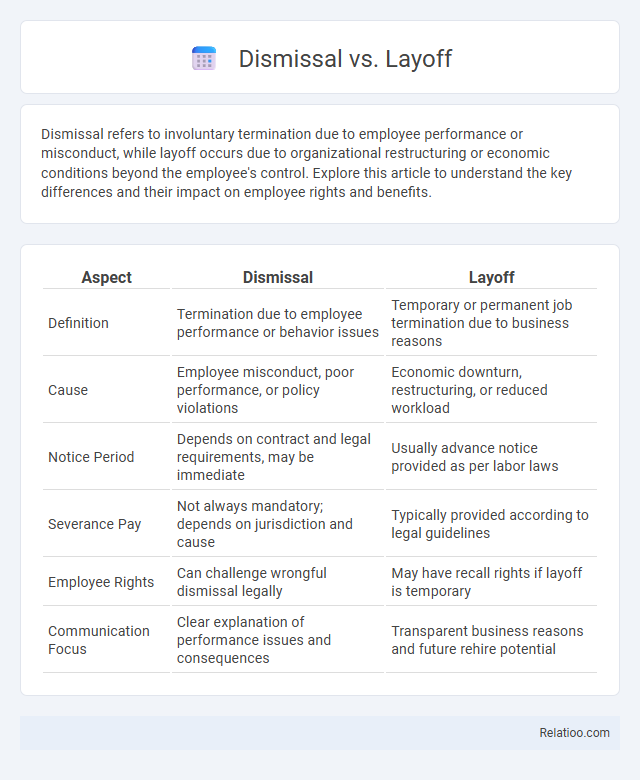Dismissal refers to involuntary termination due to employee performance or misconduct, while layoff occurs due to organizational restructuring or economic conditions beyond the employee's control. Explore this article to understand the key differences and their impact on employee rights and benefits.
Table of Comparison
| Aspect | Dismissal | Layoff |
|---|---|---|
| Definition | Termination due to employee performance or behavior issues | Temporary or permanent job termination due to business reasons |
| Cause | Employee misconduct, poor performance, or policy violations | Economic downturn, restructuring, or reduced workload |
| Notice Period | Depends on contract and legal requirements, may be immediate | Usually advance notice provided as per labor laws |
| Severance Pay | Not always mandatory; depends on jurisdiction and cause | Typically provided according to legal guidelines |
| Employee Rights | Can challenge wrongful dismissal legally | May have recall rights if layoff is temporary |
| Communication Focus | Clear explanation of performance issues and consequences | Transparent business reasons and future rehire potential |
Understanding Dismissal and Layoff: Key Differences
Dismissal refers to the termination of an employee's contract due to performance issues or misconduct, while layoff occurs when an employer reduces staff due to economic reasons, restructuring, or lack of work. Key differences include that dismissal is often employee-specific and linked to fault, whereas layoffs are generally non-personal and based on external business factors. Understanding these distinctions is crucial for both employers and employees to navigate employment law and workplace regulations effectively.
Definition of Dismissal in the Workplace
Dismissal in the workplace refers to the termination of an employee's contract by the employer due to reasons such as misconduct, poor performance, or violation of company policies. Unlike layoffs, which are typically driven by organizational restructuring or economic downturns, dismissal is generally linked to the employee's actions or behavior. Understanding the definition and grounds for dismissal is crucial for both employers and employees to ensure compliance with labor laws and fair treatment.
What Constitutes a Layoff?
A layoff constitutes a temporary or permanent workforce reduction due to economic downturns, company restructuring, or financial constraints, rather than employee performance issues. It involves terminating employment without fault, often providing severance packages and the possibility of rehire when conditions improve. Unlike dismissal, layoffs are driven by external business needs and typically follow legal protocols concerning notice and compensation.
Common Reasons for Employee Dismissal
Common reasons for employee dismissal include poor performance, misconduct, violation of company policies, and attendance issues. Unlike layoffs, which are due to economic downturns or organizational restructuring, dismissals are typically the result of individual actions that justify termination. Understanding these distinctions helps you navigate employment decisions and protect your rights in the workplace.
Top Causes of Employee Layoffs
Top causes of employee layoffs often include economic downturns, company restructuring, and mergers or acquisitions that reduce workforce needs. Layoffs differ from dismissals, as layoffs are typically involuntary and not related to employee performance, whereas dismissals result from poor conduct or failure to meet job standards. Understanding these distinctions can help you better navigate employment transitions and advocate for your rights.
Legal Implications of Dismissal vs Layoff
Dismissal typically refers to the termination of an employee due to performance issues or misconduct, carrying legal implications such as the need for documented evidence and adherence to labor laws to avoid wrongful termination claims. Layoff involves a temporary or permanent workforce reduction due to economic or organizational reasons, requiring compliance with severance pay, notice periods, and unemployment benefits regulations. Employers must carefully navigate these legal frameworks to mitigate risks related to disputes, financial liabilities, and reputational damage.
Employee Rights: Dismissal Compared to Layoff
Dismissal involves termination due to employee performance or conduct, granting workers the right to contest unfair dismissal through legal claims or severance pay. Layoff results from organizational restructuring or economic downturns, often entitling employees to unemployment benefits and recall rights based on labor laws. Unlike dismissal, layoffs typically require employers to follow notification protocols and offer reemployment opportunities, protecting employee rights during involuntary job cessation.
Severance Pay: Dismissal and Layoff Entitlements
Severance pay entitlements vary significantly between dismissal and layoff scenarios, with layoffs typically involving severance due to involuntary job loss without cause, while dismissals may not guarantee severance if due to employee misconduct. Your eligibility for severance pay depends on factors such as employment agreements, local labor laws, and the nature of the job termination. Understanding the distinctions between these terms ensures you receive the appropriate compensation and benefits during employment separation.
Impact on Future Employment: Dismissal vs Layoff
Dismissal often carries a negative impact on your future employment, as it can suggest performance or conduct issues, potentially raising red flags for prospective employers. Layoff, typically due to organizational restructuring or economic conditions, usually has less stigma and is perceived as outside your control, making it easier to explain during job interviews. Understanding these differences helps you manage your employment narrative effectively for future opportunities.
Best Employer Practices for Dismissal and Layoff
Best employer practices for dismissal involve clear communication, providing documented reasons, and adhering to legal protocols to ensure fairness and transparency. In layoffs, companies should prioritize advance notice, employee support programs, and severance packages to mitigate financial and emotional impact. Both processes benefit from respectful handling to maintain organizational reputation and foster trust among remaining staff.

Infographic: Dismissal vs Layoff
 relatioo.com
relatioo.com